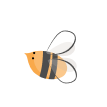- Feb 1, 2024
- Education
A PARENT'S GUIDE TO PLAY
All Wellington School Early Childhood programs emphasize play and play-based learning as a critical component. Whether the children are learning language, developing literacy, exploring numeracy or discovering the natural world, they do so through activities and experiences that are play-based.
Although a toddler’s play will look and sound different from a kindergarten child’s play, a teenager’s play, or even an adult’s play, these characteristics will be the same. Wellington School teachers understand that young children learn best through play. In fact, young children are naturally effective learners if they are allowed to explore, discover, experiment, pretend and create in play-based environments. Teachers therefore plan and provide activities and experiences that nurture and develop these natural learning responses.
Young children engage in various play activities that support essential skill development across cognitive, physical, and social domains. For instance, a toddler might spend time filling containers with water, then dumping them out repeatedly. While this activity may seem simple, it serves as a powerful tool for growth. As they pour and refill, toddlers refine their fine motor skills and hand-eye coordination. They also begin to understand cause and effect, observing how their actions lead to the movement of water. Through this play, they gain an early awareness of water’s properties—how it flows, splashes, and takes the shape of its container—laying the groundwork for future scientific curiosity.
Similarly, in a nursery setting, a child might be found making an imaginary pizza with play dough, joyfully presenting pieces to their teacher and peers. This pretend play allows the child to practice social interactions, as they use language to describe their "cooking" process and engage others in conversation. Manipulating the dough builds fine motor skills, while sharing "slices" introduces them to basic numeracy concepts, such as comparing sizes—understanding which pieces are bigger or smaller. This imaginative scenario also gives them a practical understanding of dividing items equally, concepts foundational to math skills like dividing and understanding equality.
In junior kindergarten, children often enjoy building intricate structures, such as a ship made from Lego bricks. This activity requires careful hand-eye coordination, as children place small pieces together with precision. Constructing a ship encourages problem-solving, as they must figure out how different shapes and sizes fit together to create a balanced design. This process promotes an understanding of patterns and sequencing, as they stack pieces in a logical order to achieve their vision. Creativity is key here, as each child may interpret a "ship" in their own unique way, expressing individuality and imagination.
In intermediate kindergarten, physical activities such as dancing the "Hokey Pokey" help children further develop coordination and cooperative skills. This lively dance requires balance and body awareness, as children move their limbs and shift their weight from side to side. They learn oral language cues, as each movement corresponds to a verbal instruction, such as "put your right foot in" or "put your left hand out." The dance introduces directional awareness, helping them understand the concepts of "right" and "left." Additionally, the group setting fosters cooperation and teamwork, as they learn to follow instructions in unison with others, promoting a sense of community. Through each of these activities, children not only build foundational skills but also grow in confidence, preparing them for more complex learning experiences ahead.







